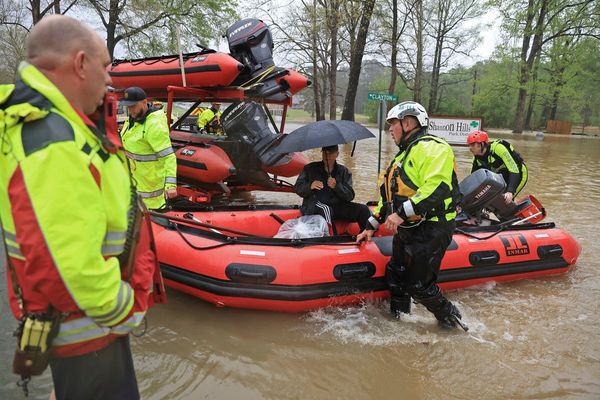
Earthquakes can neither be prevented nor predicted. If a Category 5 typhoon nears, evacuations are possible; there can be time to move to a safe zone before the pyroclastic flow of a volcano sweeps all in its path.
But when the earth shakes, it almost never comes with a warning. Even in the most technologically prepared countries, there's typically just seconds to alert operating rooms and halt trains before the devastation hits.
It's safe to say that Turkey and war-torn Syria are far from the most-prepared countries. The death toll from February's quakes is nearing 50,000 and expected to rise further with untold numbers still missing.
The damage is continuing, with more deaths coming this week from powerful aftershocks collapsing buildings that survived the initial tremors. Turkish President Recep Tayyip Erdogan has said that it was "impossible to prepare" for a disaster this big.
In terms of preventing it from occurring, that's true. But considering the saying among seismic watchers -- that earthquakes don't kill people, buildings do -- and it's convenient at best. Damage from temblors can never be eliminated, but it can be mitigated with modern building techniques. Japan, for example, has become a pioneer of cutting-edge techniques such as seismic isolation.
With over 300,000 apartments destroyed in Turkey, fingers are already being pointed at below-par building codes and corruption in construction quality and enforcement. A 2019 "amnesty" hailed by Mr Erdogan seems to have allowed builders to simply pay fines to get around standards.
Syria, meanwhile, is in no position to enforce such rules, with a dozen years of brutality by President Bashar al-Assad's regime devastating the country and bringing to the economy to its knees.
It would be a mistake, however, to shrug this off as the problems of an increasingly authoritarian developing nation and one paralysed by over a decade of war. Some experts warn that building codes in much of the US, on which Turkey's were based, mean disaster may not be so far from home.
In most US states, including those at greatest risk from quakes like California, the relevant building code is a "minimum requirement" standard that specifically assumes buildings may be damaged even beyond repair, aiming to keep construction costs low while reducing the likelihood of death.
That sounds good in theory, but in practice means that even if a temblor of expected strength hits California, the codes "are not intended to ensure a building will be useable or even repairable after strong shaking," according to one report from the Pacific Earthquake Engineering Research Center.
Its conclusions find that, if such a quake hits, the chances for "life safety" -- jargon for the prevention of deaths -- in so-called ordinary buildings such as homes, schools and offices is "likely". That's good news. But if a quake strikes at the upper bounds of what buildings were built for, that probability drops to "possibly".
The devastation of a West Coast event, even of recent magnitudes, could be much greater than many anticipate. Expectations are often rooted to the most recent occasions in living memory; for the US, this means 1989 in Loma Prieta and 1994 in Northridge. Both were below magnitude 7, causing fewer than 100 fatalities.
But quakes occur on geological timelines, not human ones. The ancient past doesn't need to be examined to find far more damaging events: the 1906 magnitude 7.9 San Francisco tremor, for example, or the Cascadia subduction zone event in 1700, estimated to have had a magnitude of between 8.7 and 9.2.
A Cascadia event is estimated to happen about once every 500 years, with the last coming before the area had been settled by Europeans. The US Navy is so concerned, it's halting four dry docks on the West Coast while it boosts safety standards. Preparations can be made. Just ask Japan. While 20,000 died almost 12 years ago when the strongest quake the country ever experienced struck off the north of the country, fewer than 5% came as a result of the shaking; the vast majority were killed in the subsequent tsunami.
That's down to tougher building standards, the result of tragic trial and error. Multiple revisions to the construction code have been made since the country rushed to rebuild after World War II. After extensive damage to housing from a tremor in 1978, it was overhauled in 1981, becoming a standard that emphasises both preventing collapse of buildings and saving the lives of those inside.
Some 80% of deaths in Kobe in 1995 came from collapsing buildings. But the damage was mainly to those made under the pre-1981 standard. Japan has doubled down, offering preferential loans for dwellings that meet newer codes.
Most buildings that suffered the greatest damage in the 2004 Niigata temblor, the 2011 disaster or the 2016 Kumamoto earthquake were built under the old code, and few had been retrofitted, according to an analysis by veteran seismic specialist Tsuneo Okada of the University of Tokyo.
The country's disposable approach to buildings has its downsides, most notably in largely static property prices. But it also means that within the next decade, the government aims to mostly eliminate the stock of pre-1981 dwellings.
Even so, experts have few delusions: a major earthquake is inevitable. Tokyo estimates a long-feared temblor directly under the city of similar strength to 1923's would still destroy as many as 175,000 dwellings from shaking alone. Combined with fires, it is expected to lead to up to 23,000 deaths. And Japan has its own history of dodgy construction issues: falsification of data has been found by both architects and firms supplying shock absorbers, while liquefaction was such an issue after 2011 that it closed Disneyland Tokyo for weeks.
Nonetheless, most estimates show lifting building standards to levels that would improve outcomes isn't hugely expensive. Over a long enough timeline, devastating quakes are certain to hit major metropolitan areas -- we just can't know when. Just as with the Covid pandemic, rich countries like the US, in theory best placed to endure them, might end up the most vulnerable. The tragedy in Turkey and Syria must serve as a wake-up call. Bloomberg
Gearoid Reidy is a Bloomberg Opinion columnist covering Japan and the Koreas.







